Alfred Silvester – the Fakir of Oolu and his Family of Magic
Chapter Eleven – Alfred William Silvester – the New Zealand Years
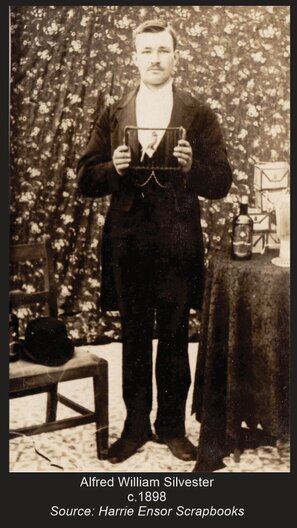
‘Professor Silvester again proved himself an adept in the art of conjuring, each trick winning rounds of applause.’ - 1912
With the demise of Alfred Silvester Silvester in 1907, all family ties back to Britain were gone, and there were no longer any performers who had been directly trained under the original Fakir of Oolu. There would be one more generation of magicians to come, and another two generations of variety performers, but much of the former Silvester magic was now becoming old-fashioned and, as 1900 approached, a new approach was needed to meet the challenges of touring conditions.
The new generation was Alfred William Silvester, son of Alfred Silvester Silvester, and grandson of the original Alfred Silvester. Since there is no longer a risk of confusing the various “Alfreds” we will refer to A.W. Silvester as “Alf”, the name by which he was best known.
Alf’s life and performance was radically different to his older relatives. Starting his career around the small population of New Zealand townships, he developed his own techniques of promotion, widened his repertoire to include nearly every facet of variety performance, and became a touring performer in the great tradition of Australian variety troupes. By doing so he achieved what his elders could not; he learned to deal with small towns, vast distances, audiences indifferent to the old familiar faces, and economic conditions which stopped many in their tracks.
This chapter has been particularly difficult to research. Alf Silvester’s career straddled two countries, a number of different performing partners and two different stage names, not to mention the obscurity of his personal life and relationships. In the absence of public records, it will be necessary to sometimes make a ‘best guess’ based on available facts. Where there are matters of personal reputation involved, we will confine the story to what is known for certain.
Early History of Alfred William Silvester
One genealogical site, and indeed one of Alf Silvester’s own promotional brochures, states that he was born in Calcutta in 1875. There is no foundation for this claim; his parents had travelled from Australia to New Zealand to perform with Alfred1, and in mid-1875 they decided to remain for a time in New Zealand (see Chapter Three). Alfred William’s birth is registered in July 1875 at Christchurch.
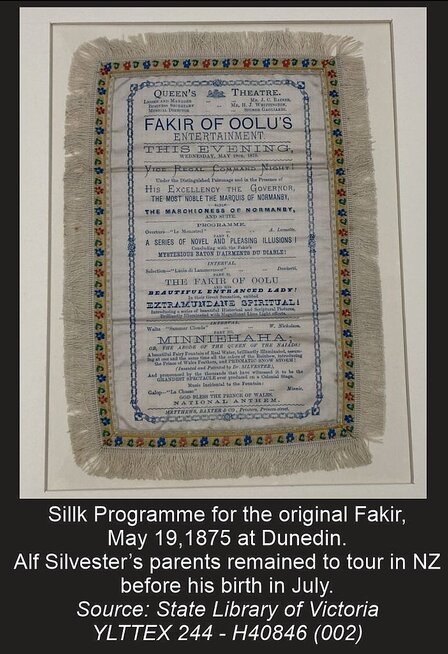
There is no available evidence to show that Alf assisted his father, or performed solo, as a young boy living in Western Australia during the 1880s (see Chapter Seven). Even so, he must have received some training in magic as his later repertoire would echo some of his father’s magic, including the Vanishing Birdcage which Alfred2 had designed for himself after seeing Harry Kellar’s performance. He was, by 1893, a competent performer of magic.
When Alfred2 split with his wife Louisa, she took her girls to Melbourne and, after a time Alfred2 and his son Alf left Western Australia together and also headed for Melbourne. It seems that Alf then went to live with his mother and sisters, as newspaper reports of Louisa’s predicament mentioned three children, as late as 1893. In that year Alf was approaching eighteen and might well have been expected to be making his own way in the world, or helping to support his siblings.
When Alfred2 split with his wife Louisa, she took her girls to Melbourne and, after a time Alfred2 and his son Alf left Western Australia together and also headed for Melbourne. It seems that Alf then went to live with his mother and sisters, as newspaper reports of Louisa’s predicament mentioned three children, as late as 1893. In that year Alf was approaching eighteen and might well have been expected to be making his own way in the world, or helping to support his siblings.
Donald Dinnie and the Vaudeville Troupe of Varieties
Donald Dinnie (1837-1916) was a Scottish strong man, and one of the first to market himself as a ‘celebrity sports star’. He was skilled in running, hurdles, high jump and Scottish strength feats including the shot, caber and hammer throwing.
Strength displays were his forte; in 1860 Dinnie made his fame by carrying two granite boulders totalling 733 pounds (332 kg) now known as the Dinnie Stones, for more than 17 feet (5.2 m) across the width of the Potarch Bridge. He became a marketing phenomenon and in 1893, at the age of 57 and just past his peak years, was in Australia making appearances outdoors and in theatres.
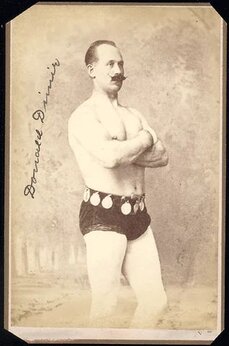

Dinnie decided to head up a touring variety company named the “Vaudeville Troupe of Varieties” and in March 1893 the troupe was appearing in Melbourne, featuring dancers and singers along with Dinnie’s athletic displays. In June he announced his intention to take the variety company over to New Zealand, starting at Invercargill at the far southern end of the South Island.
It is not known whether Alf Silvester joined the troupe in Australia (he was not mentioned in any promotions there), but by July 1 the New Zealand Herald announced that Dinnie’s company included Miss Ida McDonald, dancer; Miss Maggie Smith, ballad singer; Mr. Alf Sylvester, contortionist and conjuror; Mr. Sam Walton, acrobatic song and dance man; and Evie Dinnie, the ‘child wonder’ (aged six, she danced the highland fling and the sword dance.)
It is most likely that Alf had signed with the troupe in Melbourne and travelled across to New Zealand. As it happened, Invercargill would then become his home for many years. Like much of the rest of the country, the population was relatively small, well under 10,000 during Alf’s time, and today less than 50,000. In the same way that Alfred2 had needed to contend with a small catchment of potential audience members, Alf would have to learn how to draw in his viewers, and he was already developing a wide range of skills in addition to conjuring (as shown by his billing as a contortionist), giving him a repertoire which would provide a constant source of interest to his customers.
At this stage, still in his late teen years, Alf was a capable magician even if quite a beginner in the public arena. As the Donald Dinnie troupe progressed around the country, Silvester was commended for his magic, indicating that he must have already been well-educated in the art despite the absence of any prior advertised performances that can be found. One press review said “Mr Alfred Silvester performed several very clever tricks of slight-of-hand, and, as he is a very young man, with a little more experience and more to say, he will doubtless follow closely in the footsteps of his [uncle – sic.] in his profession.” The Dinnie troupe went through the usual vagaries of theatrical life, with audiences dependant on the prevailing weather, and mostly their notices were good (at Oamaru the paper said on August 26, “the entertainment is not by any means high class, but what the company do they do to the best of their ability, and in some case that is not to be despised.”) At Victoria Hall in Marlborough (October 20), “the conjuring of Mr Sylvester was really good, and his sleight-of-hand tricks cleanly done … the character singing of two members of the company, however, was excruciating, and would never have been missed.” Elsewhere it was noted that Alf’s routine included magic with hats, glasses, ropes etc.
Dinnie was not greatly impressed with the results of his South Island tour, and by June of 1894 he was contemplating a return home, unless the North Island proved more lucrative. “I can make a lot of money at athletics in England yet,” he told the Fair Play magazine. In the event, Dinnie was still in New Zealand until early 1898, though Alfred’s connection to the performing troupe faded away relatively quickly, early in 1894 after performances in the North Island.
Alfred in Invercargill
For a good many years to come, young Alf was only an occasional performer. There is, as a result, very little public information about his life, employment, or activities. The clearest information available about his home life in New Zealand comes from many years down the track when, in 1927, his wife Evangeline sued for divorce. At the risk of telegraphing the story, these short paragraphs from the newspapers give context to the years 1894 – 1915:Evening Star, September 5, 1927 "... the parties were married on June 20 1900 at Invercargill. Respondent was ‘some kind of theatrical’ and had left his home from time to time in the course of his profession. For many years the wife had maintained herself. In February 1920 respondent went to Sydney and had not returned. His present whereabouts were unknown. Petitioner said that respondent was a storeman when she married him, but he later took engagements with small theatrical companies as a conjuror. She received a few letters from her husband after he went to Sydney, but no money."
Otago Times, September 6, 1927 – “the respondent was a theatrical employee.”
The divorce report was incorrect to the extent that Alfred had gone to Australia as early as 1915, but we will return to that story later. Alfred, then, had settled in the southern town of Invercargill after leaving Donald Dinnie’s troupe, and was employed as a storeman, possibly in connection with theatrical interests, while his wife did not take part in his conjuring performances. He was an athletic young man of sturdy build, and was mentioned regularly in the Invercargill papers taking part in athletic events, particularly short-course running.
Evangeline Trow (1882-1963) (1), whom Alfred married in June 1900, was the daughter of Mrs. Eliza Trow and Mr. Albert Henry Trow (1853-1908) from Wiltshire in England, a well-liked resident of Invercargill whose occupation was “carter”. Evangeline and Alfred had four children, of whom only two survived into adulthood:
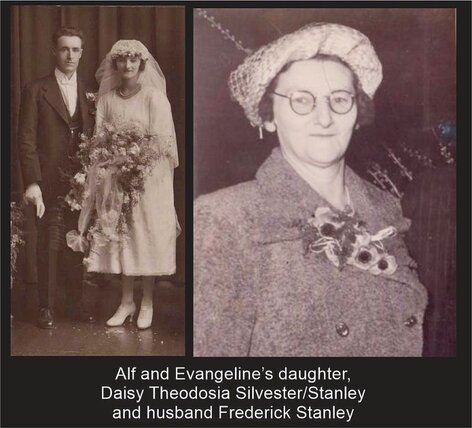
- Daisy Theodosia Silvester 1901-1953. She married Frederick Burke Stanley, a painter, in 1923 and had several children; the family lived in Dunedin (2). The name ‘Daisy’ followed the two girls of that name from the earlier Silvester family. Daisy Theodosia also had a daughter named Daisy who sadly died in the same year of her birth (1925).
- Harold Henry Alvington Silvester 1902-1904. The name ‘Alvington’ was a family tribute to the son of the original Fakir, Alvington Oak Silvester. Harold was tragically drowned in the race of a flax mill on the Wairikiki estate in Mataura, in September 1904.
- Cecil Lancelot Silvester 1905-1989 appears to have worked as a shopkeeper and in the seafood supply industry around Dunedin. He died at Christchurch, September 24, 1989.
- Alfred Mullarkey Silvester 1908-1908 may have died at birth or soon after. The name ‘Mullarkey’ came from Alf’s sister Violet, who was married to Richard Mullarkey.
It might be assumed that, since his children received names from other parts of the family, that the extended family had kept in touch with one another. None of these children would be involved in Alf’s theatrical ventures and, since it is plain that Evangeline was not his regular stage assistant, we need to look more closely behind the various stage names of those assistants.
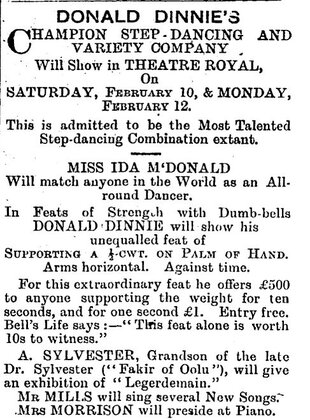
Tours and Appearances 1894-1910
To return to the Donald Dinnie tours, Alf was in the North Island at Poverty Bay (Gisborne) in February 1894. Soon afterwards, in June, Alf’s uncle Charles also arrived at Poverty Bay on tour with Eleanor and their children.While there is no record of them meeting, in April 1895 Charles and Eleanor performed at Queenstown, and their advertising now announced “8 Star Artists”, with contortionists and jugglers. A handbill printed at Queenstown refers to ‘The Silvester Brothers – Alfred William and Ernest’ who were of course cousins. Alfred had joined the company, possibly as early as February, and would continue to travel with Charles to the end of his New Zealand tour, and then over to Western Australia, where the family surfaced at Perth in December 1895.
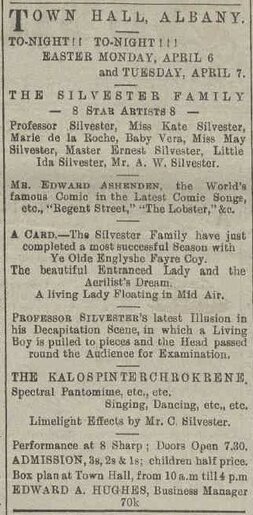
Charles’ sudden death put an end to Alf’s ambitions. Aged just twenty-one, he was in no position to lead the family troupe, even had they wished to continue; and there was no money to support Eleanor and her children. Charles died on June 5, and by June 18 Alf was back in New Zealand, advertising a grand entertainment at the Invercargill Town Hall under the billing “Alf Silvester’s Minstrel and Variety Company”. A performance in Woodlands Hall followed on July 1, but there was no extended tour. In 1897 no performances were noted, but Alf was listed as a runner in half-mile and mile running races. Similarly in each of 1898 and 1899 only a couple of performances is advertised (though others may have been presented), but there was a remark about his running: “The winner of the double was Alf Silvester, who, I think, has been round your way juggling, swallowing cannon balls, etc. He has a splendid style, and the way he cut down his fields was magnificent. I verily believe he could have won from scratch.”
At a holiday show for Race Night on February 8, 1899 Silvester was billed to perform Cabinet and rope Tying feats – mainstays of his father’s act. The performance he gave at Invercargill on February 14 was with a community fundraiser for the local pipe bands. “Mr. Silvester” said the Southland Times, “gave an exhibition of conjuring, and completely mystified the audience. His balancing feats were also clever, and his whole performance was done with a neatness worthy of a Dante.” [Oscar ‘Dante’ Eliason, who was making a huge hit with his magic in Australia and New Zealand.]
It is a near certainty that Alf took away the magic props belonging to Charles. Amongst these was the equipment for the Aerial Suspension (Entranced Lady / Sleeping Beauty) and, if the chain of inheritance is followed, this was possibly the original equipment obtained and used by Alfred1 back in the 1860s. According to Thomas Driver (Robert Kudarz), Alf always claimed to own the original apparatus. This is not certain, and there may well have been newer versions built since that time, but if the original device ended up with anybody, it was with Alf Silvester. In any case, Alf did not have a performing partner just yet, but the Sleeping Beauty would later become his feature attraction, as it had been for both his father and grandfather.

1900 saw Alf’s marriage in June to Evangeline Trow, and within a year the couple would have their first daughter. Alf appeared in a couple of local concerts, well reviewed.
For the next decade, Alf remained a part-time performer, mostly in his local region in the South with appearances at festivals and social events. It may be that some of his shows were not mentioned in the press, but for the most part he is seen fairly regularly with conjuring, juggling and ventriloquism, but with no indication that he was attempting to break into a full-blown touring career. He used the billing “Alf. Silvester’s Novelty Co.” at times.
November 1901 was significant, as for the first time, Alf exhibited the aerial suspension illusion at the Otautau All Nations Fair. His assistant’s name was not mentioned.
It was in 1903 that Alf seems to have taken a shot at touring, though in the event he was discouraged by poor weather. As the “Lex McLean Silvester Co.” a variety troupe travelled through many towns in the South Island between February and November. Lex McLean was a Scottish athlete and strongman known as the Scots Hercules, ostensibly on a world tour, who would remain in New Zealand for several more years as a theatrical act and lecturer on physical strength (3). Also with the troupe were Miss Rosa La Venda (song and dance), Miss Beattie (child vocalist), Alf Williams (Irish Comedian), Miss Antonia (equilibrist and sword swallower), Carl Collier (banjoist) and ‘Madame Silvester’ who, on this occasion, seems to have been Evangeline, since ‘Eva and Alf’ are mentioned with illusions and drawing-room entertainments. The task of being hoisted into the air as ‘Sleeping Beauty’ or ‘Mesmerism Up to Date’ was given to the young Miss Beattie.
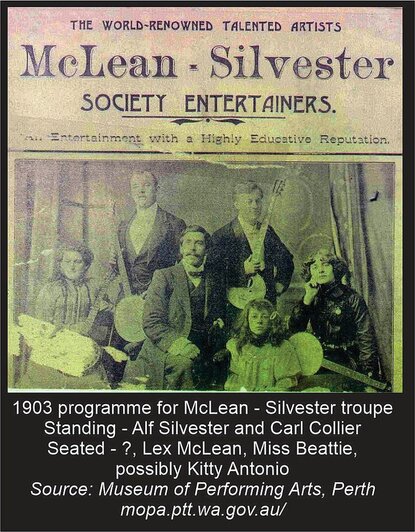
At Tuapeka in February, “Mr Silvester proved himself an expert in the art of conjuring, his tricks being performed with a neatness which was perfectly mystifying to the audience, and as a mesmerist he also gave a very clever performance … Mr Lex McLean gave an exhibition of feats of strength, juggling with dumbbells and bar bells from 56lb up to 200lb weight as easily and with apparently as little effort as an ordinary man would with a quarter of the weight … met with an enthusiastic reception, each feat in turn being loudly applauded.” McLean also displayed the feat of lifting a 3cwt piano above his head.
The illustrated programme for the 1903 tour is interesting for its photographs of the Sleeping Beauty illusion, though they have been carefully prepared to hide any support. Alf Silvester claimed to have been born in Calcutta (presumably more exotic than Christchurch), and one of his reproduced reviews, supposedly from Hobart in 1900, cannot be located in any form.
Reviews of the company’s performances was consistently good, but audience numbers varied. Around the end of July McLean moved on, and several of the company jumped across to, firstly, the comedian Martyn Hagan’s Comedy Company, and then to Bland’s Entertainers, seeing the year out with a tour of the Otago Goldfields regions. Alf advised the Otago Witness, “our business was greatly interfered with by the continual rain and bad weather. We have arranged a tour for the Southern District taking in all the ‘smalls’ and hope to do fair business.”
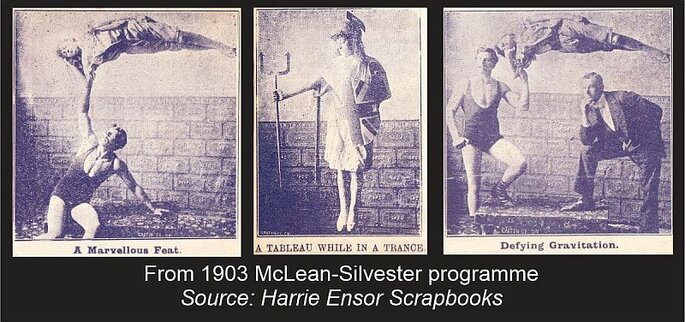
The year 1904 reveals no further touring, and the only mention of the family was in September, with the tragic drowning of the Silvesters’ son, Harold. He went missing from the house at a local flax mill for only ten minutes, but was discovered caught in some pegs placed across the ‘race’ to stop the flax from running over the waterwheel. The funeral left from Mr Henry Trow’s home in St. Andrews street, North Invercargill, for the Eastern Cemetery.
As 1908 and 1909 went by, Alf slightly increased the frequency of his appearances, largely with the troupe under the banner of ‘Allan’s Entertainers’, and now they started moving around both islands of New Zealand, as far North as Hastings. Mr Will Clair gave a comic acrobatic performance, the Zilvonis Brothers presented a Second-Sight routine, a passing parade of female singers gave ballads, Silvester had his aerial suspension and other feats under the title ‘A Night in Fairyland’, and the Lubin projector completed the evening.
At Feilding in June 1908, “A varied and interesting programme was given .. Silvester, a conjuror, set the ball rolling with some tricks with handkerchiefs, bottles, glasses and other vehicles; and a séance followed. In this, another member of the company, who was blindfolded, described from the stage articles in the possession of the members of the audience … some extremely good conjuring tricks were given by two of the troupe, with acrobatic turns, followed by sundry exhibitions of fire-eating. A mesmeric item lent variety to the programme, and a song was nicely rendered by the fire-eater.”
Again, according to the Referee (Sydney, Nov 25) the troupe was playing successfully and “has booked dates in the Fiji Island, and opens in Suva in January.” They were, however, still in the North Island in February the next year.
1910 - Silvester becomes Silbini
At the Bay of Plenty in December 1909, a new name quietly made its first appearance. “Professor Silvester’s hypnotic powers are said to be a show in itself; a lady is floated in mid-air and during this act a number of pretty tableaux, with lime-light effects are produced. Miss Silbini’s singing is another feature of the programme. The Silvester’s second sight séance is also a strong attraction and is much after the famous Howard Brothers, late of Worth’s Circus.”
Here we see the development of a clever business device which would be used by Alf Silvester through the rest of his life. In a gradual evolution, the name “Silbini” would be applied to his assistant, then to himself, at the exact same time as “Professor Silvester” was performing on the very same bill. Without expanding the size of his company, Alf now had, apparently, a host of extra performers to attract his audiences. Whatever the audiences thought about seeing the same performer on stage as Silvester and Silbini, it was never questioned in press reports, and seems to have been accepted as just good showbusiness. The technique is similar to that routinely used by touring circuses.
In later years, the Silvester family troupe would regularly use this approach, and Alf’s step-daughter, speaking of later years in Australia would write, “Because we covered the same districts so often it was necessary to change the name of the company when travelling back to towns that had seen us perform, perhaps only a short while before. By advertising ourselves as a new show we could be reasonably sure of the townspeople turning out to see us again. We used a number of names; 'The Allan Family Bell Ringers', 'Sills Entertainers', and 'Twentieth Century Entertainers' were probably the most commonly used. If we had advertised the same touring company, using the same name each time we visited a town, probably nobody would have been interested in turning out to see us, and we could well go hungry."
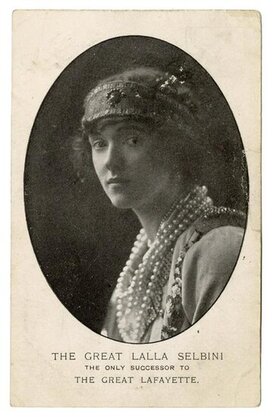
It should be noted also that the act was mentioned often as the “Selbinis”, most likely due to the usual inclination of newspaper writers to spell as it suited them on the day. The spelling is unhelpful, as there was a far more famous troupe of novelty bicyclists performing under the stage name Selbinis. Miss Lalla Selbini would become a performer of some notoriety. She was the principal assistant to magician Lafayette (Sigmund Neuberger) and took over after his tragic death in a theatre fire.
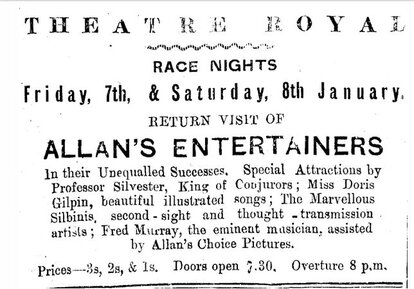
Two assistants, Miss Bland and Miss Doris Gilpin, are mentioned as early as September 1909, at Manawatu. Miss Bland was at this time, and into 1910, the assistant for Sleeping Beauty, but only a little more is seen of her until years later (1916) in Australia, when ‘Miss Maud Bland’ was again noted as being the aerial suspension assistant.
Alf was not shy of bolstering his publicity, and for his upcoming appearance at Whangarei, January 7 and 8 1910, it was claimed that “The Marvellous Silbinis alone are a show in themselves. Miss Silbini, the diviner has by her clever turns gained for the Marvellous Silbinis a household name throughout Australasia.” Allowing that Alf had once performed briefly in Australia, it cannot be said that he was anything like a household name, as yet.
We are left to assume that either Miss Bland or Miss Doris Gilpin the ballad singer also doubled as the mind-reader ‘Miss Silbini’ in the same performance. Of Doris, we do know that both she and her sister, Lily, once worked as assistants to the great illusionist, Charles Carter, in 1908, and Lily had sued for loss of income when the cage in which she was suspended, allegedly ten feet (actually six) above the ground, crashed to the stage due to a faulty chain. (5)
1910 was the year in which Alf appears to have broken away from his home base (and possibly his family), with performances spread evenly throughout the year. In March, Auckland was privileged to witness the “Marvellous Selbini Troupe, specially engaged after a triumphal tour – the whole complete bill by the Fascinating Selbinis, introducing amongst a host of Star Turns, the Colossal Selbini Illusion, The Sleeping Beauty.” The production was not strongly reviewed. Alf and Doris’ mindreading was described by the New Zealand Herald as “neither interesting nor convincing, the efforts at code work being too palpable.”
As an example of the obfuscation generated by press notices of the time, the troupe’s Auckland appearance in March was reported – “… the Selbini Troupe will give their initial performance, providing the entire programme. Will Selbini (from Wirth’s Circus) is a juggler and heavyweight lifter, who juggles with cannon balls and bar-bells of enormous weight with the greatest ease. Miss Ada Selbini, also direct from Wirth’s circus, is claimed to be the only lady wire-walker in Australasia, who balances on a ladder whilst balanced on the slack wire. Alf Selbini is billed as a clever ventriloquist, magician, and illusionist. Miss Doris Selbini gives a psychic séance, “Transmission of Thought” whilst Harry Selbini is reputed to be a clever comedian, and Arthur Selbini an accomplished musician.” And with that, we must give up and accept that “Selbini” or “Silbini” applied to whoever was currently appearing in the show! We can obtain some insight into the real performers, from a later appearance which mentioned an Alf. Williams, Harry Gordon, Doris Gilpin, Ada Gallanzo ‘Queen of the Invisible Wire’ and the Juggling Gazzas.
Travelling with these same performers under the banners of the ‘Maurice Vaudeville Company’ and ‘West’s Entertainers’, Alf’s magic was well reviewed (“… thoroughly mystified the entire audience, and some of his experiments were really sensational.”) and the tour was successful through to the end of the year. The same West’s troupe was seen at various dates throughout 1911, and at Blenheim on January 31, ‘Professor Silvester’ introduced a number of attractions which echoed the Silvester lineage – Sleeping Beauty, Le Salon Du Diable (the ‘Enchanted Canopy’), and Shu-Sin-Fa which was described as “a sparkling, splashing, silvery vision, showering perfumed sprays of refulgent splendour from a heaven of azure through soft blue rays of the electric light”; which we must assume was a version of the Fakir’s ‘Fairy Fountain.’ The Marvellous Silbinis were reported as though they were an entirely different act to the magic of ‘Silvester’.
In February, for the first time, a specific reference was made to ‘Professor Silbini’ and, by June, Alfred was appearing almost entirely under the name Professor Silbini. In September, he was working with Burton Bros. circus, with the Sleeping Beauty, Second Sight with Miss Silbini, and a comedy sketch by Alf. Williams.
Legal Problems and Hypnosis
1912 saw Alf Silvester in some trouble. He was still touring with the same companions and performing under the joint names of Silvester and Silbini, and claiming to have just returned from an extensive tour of the Fiji Islands and India. (6) Alf’s repertoire had expanded to cover bell ringing, lightning changes, juggling, ventriloquism, and a hypnosis act which was more than just the faux mesmerism of his aerial assistant.
Alfred was held, in June, to be the father of an illegitimate child and was ordered to pay support and past maintenance costs. While the detail is best passed over, the mother was Doris Gilpin who, as late as April, had still been performing with Alfred. By July Alfred was threatened by the courts at Palmerston with three months’ imprisonment unless he paid his maintenance. A warrant was later issued at Christchurch for his arrest, and he was temporarily lodged in Wellington Prison. The issue of financial support followed Alf until November of the following year, when he was released from an order against him, provided he paid 15s a week off his arrears.
A further blow-up took place at the end of 1912, in which Silvester was embroiled, though there is no suggestion that he was involved in any wrongdoing. Silvester had joined up in company with a man name Peard, and another whose real name was Walter McIvor (7) but used the stage name Walter Braemar. Mr Braemar had advertised for someone to put capital into a show, and Peard (aged just 19) was the money man, but Silvester declined to join up unless he was given £22 in advance; a wise move.
The show, it was alleged, was run on a dubious basis – at first it was billed as being the “Jansen Co.” hinting at a connection with Harry Jansen the magician. At Methven (near Christchurch) the show became the “Nicola Co.” in imitation of the famous illusionist of that name, and according to court transcripts Braemar intended to skip town without paying for lodgings or other expenses. On learning this, Peard recognised himself as a ‘dupe’, and recouped what he could, before departing the company and leaving them stranded in Methven.
The court allegation was that Mr. Peard had stolen a watch belonging to Braemar. Silvester, in court as a witness, said that the only good watches in the company belonged to Peard and himself, and that Braemar’s watch “was an apology for one, which went when its owner went, and was the joke of the troupe.” He also testified that he performed the majority of the show by himself. Ultimately the case against Peard was dismissed. Silvester cut his losses and finished out the year at Timaru’s Bijou Theatre. His experience with Braemar/McIvor did not prevent him from appearing on the same bill with Breamar’s hypnotic show briefly in May 1913 (8), and it may be that Silvester learned some of his hypnotic skills from Breamar, who continued to be seen as a hypnotist in New Zealand until early 1915.
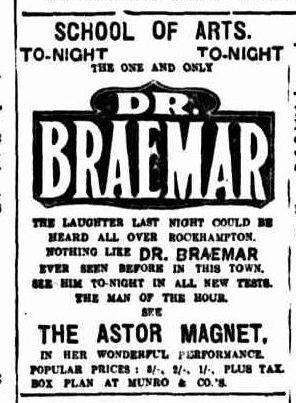 There is one other curious fact in this tale. In 1913, Walter McIvor married Doris Gilpin, through what circumstances we do not know. (9) ‘Dr. Braemar’ was seen in Queensland, Australia, during April 1921 as a hypnotist, and was accompanied by an act named ‘The Astor Magnet’ who performed mindreading and feats in which the strongest of men were defied to lift her from the ground. It might be speculated whether the Magnet was Doris Gilpin.
There is one other curious fact in this tale. In 1913, Walter McIvor married Doris Gilpin, through what circumstances we do not know. (9) ‘Dr. Braemar’ was seen in Queensland, Australia, during April 1921 as a hypnotist, and was accompanied by an act named ‘The Astor Magnet’ who performed mindreading and feats in which the strongest of men were defied to lift her from the ground. It might be speculated whether the Magnet was Doris Gilpin.Alf Silvester continued to move about the country, adding the Shadowgraphy routine ‘Masks and Faces’ to his repertoire. He joined the Royal Lyceum Pictures and Entertainers troupe, with an act strongly weighted towards hypnotism, but still presenting the aerial suspension, ventriloquism and magic. The assistant’s name is not known as anything other than ‘Miss Silbini’, but she presented the second-sight and thought transmission routine. The novelty musician, Will Marmon of the Marmon Bellringers (10), was also on the bill, and his musical exhibitions with water-filled glasses, xylophones and banjos may have inspired Alf to pass on those talents to his step-daughter, Ida, in later years.
Rhoda the Mysterious
Alfred was performing at the Gore Town Hall in January 1914, when a new name, ‘Rhoda Silbini’ came to the fore and, since her history adds further layers of confusion to the already convoluted Silvester saga, we will attempt to unravel her life story before continuing.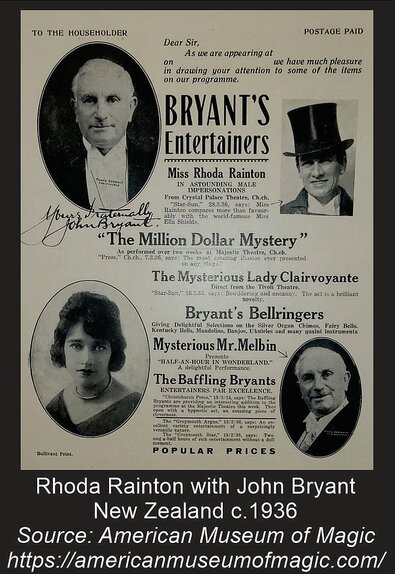
Rhoda Beatrice Rainton was born in 1897 to John Henry Rainton and Annie Eliza Rainton, of Dunedin. Her father was a waterside worker who died in 1913, not long before Rhoda commenced working with Alf Silvester. Annie Rainton survived until 1945, known as “Gran of Worcester Street” performing charitable works in Christchurch.
Rhoda had a child in 1914, named Alfred Edward John Rainton; but aside from the first name there seems to be no suggestion that Alf was the father. Rhoda would work with the Silbini/Silvester company until 1918, firstly in New Zealand and then in Australia, as the Second Sight performer and singer, and it might be assumed that during this time any reference to ‘Miss Silbini’ equates to Rhoda Rainton.
During this time, advertising made mention of a ‘Gwen Rainton’, billed as a male impersonator; in later years Rhoda Rainton would become very well-known as a singer of baritone vocals and “Burlington Bertie” songs. Since Gwen is not mentioned in any family tree as a sister of Rhoda, we are forced once again to conclude that ‘Gwen’ was just another faux name used in advertising.
In 1917, the name of Mr. J. Bryant appeared with the Silbini troupe. John Bryant, a multi-talented performer whose origins are difficult to determine, formed a relationship with Rhoda Rainton, and by 1918 the pair had left to perform on their own account. The Bryant/Rainton pairing would continue for many years to come, as late as 1938, chiefly under the banner of ‘Bryant’s Bellringers’ or ‘Bryant’s Entertainers’.
Frustratingly for the researcher, when Rhoda departed from the Silvester company, she continued to use the name “Rhoda the Mysterious”, performing the mindreading act, and a version of the aerial suspension.
Her partner John Bryant was also, among a versatile musical repertoire, a performer of magic under the name ‘Mysterious Mr. Melbin’, but it is certain that they were completely separate from Alf Silvester. Together, Rainton and Bryant toured widely in Australia and New Zealand as a busy and successful vaudeville company, and in 1945 Rhoda and John were married in New Zealand. Rhoda died on July 5, 1964 at Christchurch.
Final Years in New Zealand
The emphasis of Alf’s act during 1914-1915 was strongly towards stage hypnosis. Gradually the name ‘Silvester’ began to disappear from advertising, and the company was promoted as ‘The Mysterious Silbinis’. Although the Second Sight exhibition was still given, the lady was suspended in the air and Will Marmon continued to perform his novelty music, Professor Silbini was promoted as a hypnotist, and his big drawcard was to place a local person in a cataleptic sleep, then place the person on view in a shop window for two days. The usual comedy stunts were done onstage; volunteers kissing a pig thinking it was a baby, eating mustard for jelly etc.
Combined with a series of motion pictures, the show toured widely and played to large audiences. Silvester was now well established in his career, with a vast array of talents in his repertoire. A representative sample of his press reviews comes from the Lyric Theatre in Nelson (June 4, 1915)
SILBINI ENTERTAINERS:
Silbini and his clever company of entertainers achieved a remarkable success last evening at the Lyric Theatre, when they were warmly welcomed by a packed house. Silbini opened the proceedings with his grand magical entree, "Twenty Minutes in Wonderland," introducing the mysterious patriotic illusion, ‘Where is the German Flag??',The Flight of Birds, The Magic Cage, and other weird items. Marmon, the Musical Wizard, late of Marmon Bellringers, America, proved himself a musician of parts, and his selection on the glassophone and banjo were greatly appreciated. Mr Silbini then explained the difference between conjuring and juggling, and gave a remarkably skilful display of his proficiency in both accomplishments and was warmly applauded. Miss Silbini is another star, who as a second-sight medium has baffled many scientists and sceptics throughout the colonies with her mysterious astounding performances. She described all manner of articles held by the audience, and gave details regarding lost articles and missing friends. Enthusiastic applause followed this part of the proceedings. As an eccentric comedian Will Marmon is just the thing, and his ‘business’ and funnisms are refreshingly novel. Silbini is also a ventriloquist of no mean order, and his automatic doll ‘Tommy Terror,’ received a great hearing, and was quite a feature of the evening. The performance concluded with the sensational illusion, ‘The Aerial Flight,’ with tableaux and limelight effects, and this puzzling illusion brought a first-class and wholesome entertainment to a conclusion. There will be another performance this evening, when a complete change of programme will be presented. Silbini will conclude his Nelson season to-morrow, afternoon, when a matinee will be given, commencing at 2.30. Between the hours of 1 and 2, Silbini will appear in the streets disguised, and the first boy or girl identifying the magician will receive a prize of half-a-guinea.
(In his publicity stunt, Alfred attempted to deceive the population by appearing in female disguise, but was spotted by a young girl.)
At the end of June 1915, Alf Silvester departed New Zealand, leaving behind his wife and family from whom he had already been separated for several years. He was headed for Australia and decades of the most remarkable touring adventures.
REFERENCES FOR CHAPTER ELEVEN
(1) Evangeline was born on May 4, 1882 – https://www.ourfamtree.org/descend.php/Henry-Weston/57087
Another daughter, Florence was born September 20, 1883. The Trow parents had seven children including Evangeline.
(2) Stanley family detail from https://caversham.otago.ac.nz/dbaccess/index.php
(3) McLean published a booklet, "Health, strength and Beauty" in 1902
(4) “Ida – The Lady on the Silver Wire”, the memoir of Alfred William Silvester’s step-daughter, Ida Harwood, which will be discussed in detail in the next chapter.
(5) New Zealand Times, April 3, 1908
(6) Otautau Standard January 30, 1912, and Waimate Advertiser April 10, 1912
(7) News reports spell this name variously as M’Kiver, McKiver and McIvor; we are inclined towards McIvor as being correct.
(8) At Gore Town Hall, c.May 17, 1913 with the Royal Lyceum Pictures and Entertainers.
(9) Birth and marriage records connected to Doris Gilpin have been sourced through the New Zealand Births, Deaths and Marriages online database at
https://www.bdmhistoricalrecords.dia.govt.nz/Home/
https://www.bdmhistoricalrecords.dia.govt.nz/Home/
Doris and Alf’s son was Herbert Alfred Gilpin (1910 – 1932)
(10) Though the skills of ‘Will Marmon’ are not in doubt, the Marmon Bellringers cannot be located anywhere other than in Alf’s advertising. In later years, Vera Williams/Silvester would also be advertised as ‘late of the Marmon Bellringers, USA’ and the suspicion is that this was another promotional ploy.